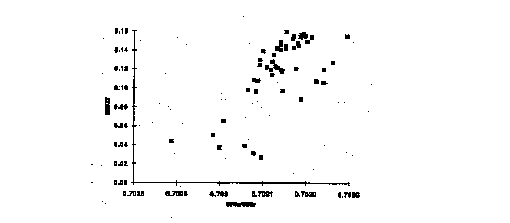
The Reykjanes Peninsula S. W. Iceland has featured in many studies attempting to constrain melting processes of plumes (e.g. Elliott et al., 1991, Hemond et al., 1993). This area provides an excellent opportunity for such study because the tectonic regime of a mid-ocean ridge is superimposed on Icelandic Plume mantle. Adiabatic melting in the extensional environment enhances the plume mantle potential temperature whilst the associated tectonic regime permits eruption of small volume melts. In addition the thin crust (ca 6 km) offers little opportunity for contamination and/or homogenisation of melts unless a robust long lived high level magma chamber is in existence.
A suite of spatially well constrained samples from Reykjanes cover a wide range in MgO (5-29 wt %), and are generally less than 70 ka old. The samples have been traced to source and their geochemical variation expressed relative to distance along the ridge axis. From this it can be concluded that over the time period covered there has only been one robust magma chamber on the peninsula SW of Hengill. Away from this area eruption of melts with a wide range of trace element ratios, e.g. Nb/Zr from <.05 to > 0.15 occurs within the same fissure system. Lavas with ca 10 wt % MgO span the full range of Nb/Zr, whilst high-MgO (>12 wt %) aphyric samples exist at both high and low Nb/Zr. Such a range in trace element ratios could be generated purely by melting processes, such as remelting a residue. However there is a positive correlation between Nb/Zr and 87Sr/86Sr (Fig. 1), negative with 143Nd/144Nd, suggesting that different sources are needed.
These sources can be defined by isotopes and trace element ratios. (Kerr et al, 1995). The more depleted (in radiogenic Sr and Nb/Zr) source has not been found in evolved samples (< 9 wt % MgO), whilst more radiogenic Sr, high Nb/Zr samples exist across the full range in MgO. That the depleted component is Icelandic Plume rather than MORB is suggested by the Pb isotopic characteristics (Thirlwall, 1995). This component is only seen in relatively small volume eruptive units, some with olivine as the sole major phase on the liquidus. As the high Nb/Zr source will dominate the melt when the two components are mixed the depleted signature will only be present in areas such as Reykjanes, away from large homogenising magma chambers, where melts from small volumes of mantle are permitted to erupt.
Elliott, T.R., Hawkesworth, C.J. & Gronvöld, K., Nature 351, 201-206 (1991).
Hemond, C., Arndt, N.T., Lichtenstein, U. & Hofmann, A.W., J. Geophys. Res. 98, 15833-15850 (1993).
Kerr, A.C., Saunders, A.D., Tarney, J., Berry, N. & Hards, V.L., Geology, 23, 843-846 (1995).
Thirlwall, M. F. J Geol. Soc. 152, 991-996 (1995).
Fig. 1: Nb/Zr vs 87Sr/86Sr.